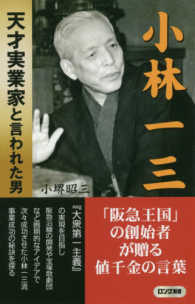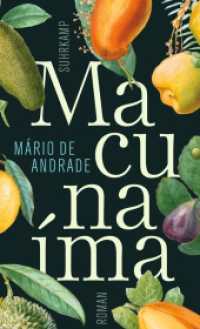- ホーム
- > 洋書
- > 英文書
- > History / World
Full Description
This volume brings together some of the latest research on the cultural, intellectual, and commercial interactions during the Renaissance between Western Europe and the Middle East, with particular reference to the Ottoman Empire. Recent scholarship has brought to the fore the economic, political, cultural, and personal interactions between Western European Christian states and the Eastern Mediterranean Islamic states, and has therefore highlighted the incongruity of conceiving of an iron curtain bisecting the mentalities of the various socio-political and religious communities located in the same Euro-Mediterranean space. Instead, the emphasis here is on interpreting the Mediterranean as a world traversed by trade routes and associated cultural and intellectual networks through which ideas, people and goods regularly travelled. The fourteen articles in this volume contribute to an exciting cross-cultural and inter-disciplinary scholarly dialogue that explores elements of continuity and exchange between the two areas and positions the Ottoman Empire as an integral element of the geo-political and cultural continuum within which the Renaissance evolved. The aim of this volume is to refine current understandings of the diverse artistic, intellectual and political interactions in the early modern Mediterranean world and, in doing so, to contribute further to the discussion of the scope and nature of the Renaissance. The articles, from major scholars of the field, include discussions of commercial contacts; the exchange of technological, cartographical, philosophical, and scientific knowledge; the role of Venice in transmitting the culture of the Islamic East Mediterranean to Western Europe; the use of Middle Eastern objects in the Western European Renaissance; shared sources of inspiration in Italian and Ottoman architecture; musical exchanges; and the use of East Mediterranean sources in Western scholarship and European sources in Ottoman scholarship.
Contents
Contents: Foreword; Section I Commercial, Artistic and Cultural Contexts: Blurring the boundaries: intellectual and cultural interactions between the Eastern and Western: Christian and Muslim worlds, Claire Norton; Sharing a taste? Material culture and intellectual curiosity around the Mediterranean from the 11th to the 16th century, Anna Contadini; The Lepanto paradigm revisited: knowing the Ottomans in the 16th century, Palmira Brummett. Section II Texts, Art and Music as Media for the Transmission of Intercultural Influences: The role of the book in the transfer of culture between Venice and the Eastern Mediterranean, Deborah Howard; The 'reception of the Venetian ambassadors in Damascus': dating, meaning and attribution, Caroline Campbell; Giacomo Gastaldi's maps of Anatolia: the evolution of a shared Venetian-Ottoman cultural space?, Sonja Brentjes; Turning a deaf ear, Owen Wright. Section III Renaissance Thought: Old and new demarcation lines between Christian Europe and the Islamic Ottoman Empire: from Pope Pius II (1458-1464) to Pope Benedict XVI (2005-13), Zweder von Martels; Turco-Graecia: German humanists and the end of Greek antiquity - cultural exchange and misunderstanding, Asaph Ben Tov; Positive views of Islam and of Ottoman rule in the 16th century: the case of Jean Bodin, Noel Malcolm. Section IV The Renaissance and the Ottoman Empire: Binding relationships: Mamluk, Ottoman and Renaissance bookbindings, Alison Ohta; Ottoman textiles in European markets, Suraiya Faroqhi; Mehmed II as a patron of Greek philosophy: Latin and Byzantine perspectives, Anna Akasoy; Bibliography; Index.








